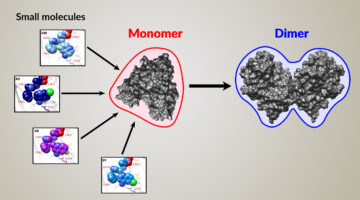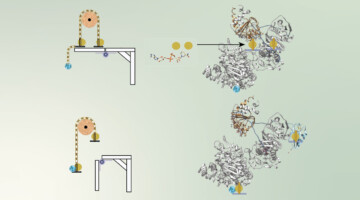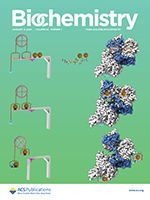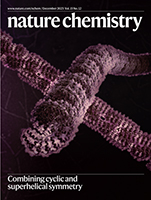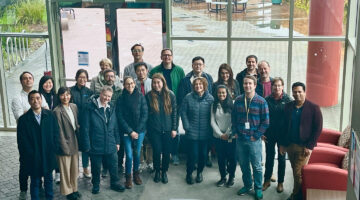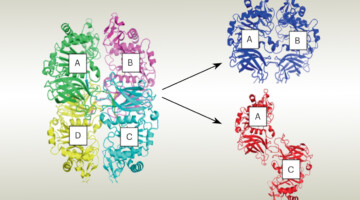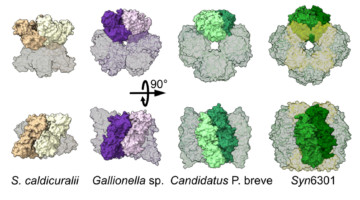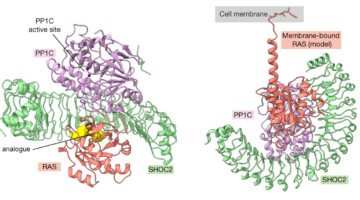Time-resolved, high-throughput, small-angle x-ray scattering improved the screening of small-molecule drug candidates, providing insight into how they stimulate structural transitions in protein targets. The work will speed the discovery of treatments designed to activate biomolecular dynamics associated with desired therapeutic outcomes. Read more »![]()
![]()
Bifurcation of High- and Low-Energy Electrons in Microbial Metabolism
A class of chemical reaction found only in biology, electron bifurcation channels two electrons from one donor to two separate acceptors, with one electron elevated in energy at the expense of lowering the energy of the second. Researchers used the ALS to study this process in a microbial protein involved in this bioenergetic pathway. Read more »
Correlating Conformational Equilibria with Catalysis in the Electron Bifurcating EtfABCX of Thermotoga maritima
Anaerobic SEC-MALS-SAXS at the SIBYLS beamline probes the conformational states behind electron bifurcation in the Thermotoga maritima EtfABCX, revealing insights on mechanisms at the thermodynamic limits of life. Shown are the bifurcation- and electron-conducting-like states experimentally observed for the first time in solution. Read more »
Computer-Aided Protein Design for New Biomaterials
Using a computer-based approach, researchers designed porous protein crystals that were revealed to be stable, tunable, and atomically accurate using x-ray scattering and diffraction at the ALS. The work provides a powerful new platform for biological materials engineering and opens up wide applications in biotechnology and medicine. Read more »![]()
![]()
How Structure Affects the Activity of Lipid Nanoparticles
Berkeley Lab and Genentech scientists related the internal structures of lipid nanoparticles to their efficacy at drug delivery, using a combination of methods including x-ray scattering at the ALS. The work promises to expedite the development of drug delivery systems for the treatment of diseases such as COVID-19 and cancer. Read more »![]()
![]()
Precisely patterned nanofibres made from extendable protein multiplexes
Superhelical symmetry can be found in helical repeat proteins, and de novo helical repeat proteins are rigid and amenable to stacking in a head-to-tail fashion, which is an important factor in building up coincident symmetries. Now, using cyclic helical repeat proteins, Baker and colleagues generate protein nanostructures—as depicted on the cover—with coincident cyclic and superhelical symmetry axes. Read more »
Breaking Barriers in Drug Delivery with Better Lipid Nanoparticles
A collaboration between Berkeley Lab and Genentech, a member of the Roche Group, is working to break through some of the drug delivery bottlenecks by designing the most effective lipid nanoparticles (LNPs)—tiny spherical pouches made of fatty molecules that encapsulate therapeutic agents until they dock with cell membranes and release their contents. Read more »
Plant Enzyme Builds Polymers That Fortify Cell Walls
With data obtained at the ALS, researchers gained insight into how an enzyme orchestrates the synthesis of a pectin polymer that imparts strength and flexibility to plant cell walls. The work could lead to improved biofuel production and guide the design of polymers with tailored functionalities for industrial or biomedical applications. Read more »![]()
![]()
Protein Assemblies Show Surprising Variability
Protein-structure studies performed in part at the ALS helped researchers discover that the protein assemblies in a key carbon-cycling enzyme can rearrange with surprising ease. The findings raise the prospect of genetically tuning the protein in agricultural plant species to produce more productive and resource-efficient crops. Read more »![]()
![]()
Structures Signal Fresh Targets for Anticancer Drugs
Researchers from Genentech used a suite of methods, including small-angle x-ray scattering, to learn how an assembly of three proteins works together to transmit signals for cell division. The work reveals new targets for the development of drugs that fight certain types of cancer, including lung, colorectal, and pancreatic cancer. Read more »![]()
![]()
- 1
- 2
- 3
- 4
- Next Page »
